 2ND LEAD
2ND LEAD
Ancient port near Hambantota had Dravidian name mixed with Prakrit
[TamilNet, Thursday, 16 September 2010, 18:14 GMT]
Jars, Black and Red ware pottery and some timber sections were found in 2008 at a depth of 31 metres under sea, at a probable shipwreck site around 3 km off the coast of Godawaya, between Hambantota and Ambalantota in the Southern Province. Earlier, divers retrieved a stone bench having symbols engraved on it from the site. Stone pillars, probably remains of an old maritime structure were excavated and reported in 2001 at Godawaya fishing village, while a stone anchor was found in the sea near the coast in 2003. A late Brahmi inscription of 2nd century CE found on a rock at the Buddhist temple of Godawaya gives the ancient name of the port as Goda-pavata Patana, which is largely Dravidian mixed with Prakrit.

Remains of a jar at the probable shipwreck site. [Image courtesy: archaeology.lk]
Rasika Muthucumarana, Maritime Archaeologist of the Maritime Archaeology Unit of the Central Cultural Fund, Galle, wrote an article Monday, “Godawaya: An Ancient Port City (2nd Century CE.) and the Recent Discovery of the Unknown Wooden Wreck”, in archaeology.lk in which he discussed the maritime finds at the site.
He cited the Late Brahmi inscription found at Godawaya, recorded by S. Paranavitana earlier, in which the old name Goda-pavata Patana is found.

The Late Brahmi inscription found on a rock at the Buddhist temple at Godawaya. The marked part in the inscription gives the ancient name of the port, Goda-pavata Patana. [Image courtesy: archaeology.lk. Marking by TamilNet]
“The name Godapawatha, Gota pabbata or Godawaya means, mountain with boulders (Gota – Short and round / Pabbata – Rocky Mountain),” the archaeology.lk article says (see link below).
The interpretation of the place name brought out in the article may need modification and further explanation to understand its significance, an academic comment received by TamilNet said.
The comments follow:
The inscription clearly gives the spelling of the prefix as Goda and not as Gota.
Goda in Sinhala means heap, mass or land at water’s edge. Godæalla in Sinhala is hill, mound or rising ground. Goda is a very popular place name component in Sinhala in the names of places having rocks, hillocks, rocky hills, peaks and banks. In this sense, Goda also means a village or hamlet in Sinhala.
As Goda, in one shade of its meaning stands for land at water’s edge, the verb Godabaanawaa in Sinhala means, to unship, to unload, to land, to disembark etc.
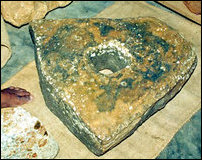
Stone anchor found in the sea near Godawaya. [Image courtesy: archaeology.lk]

Small stone bench found in the seabed at the site of a probable shipwreck, 31 metres deep and 3km off the coast of Godawaya. [Image courtesy: archaeology.lk]

The symbols engraved on the stone bench found at the probable shipwreck site. Keeping the Srivatsa symbol at the centre, Nandipada, fish and ladder are on either side. [Image courtesy: archaeology.lk]
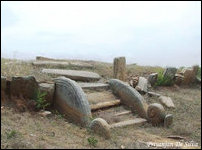
Ruins on the Godawaya hillock. [Image courtesy: Google Earth]
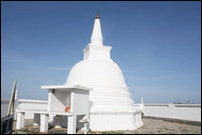
The present stupa at Godawaya hillock. [Image courtesy: Google Earth]
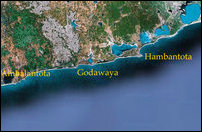
Location of Godawaya at the old mouth of river Walawe Ganga, between Hambantota and Ambalantota. [Image courtesy: Google Earth, Legend: TamilNet]
Goda is a close cognate of Koadu in old Tamil and Malayalam, which means, hill, hillock, peak, summit of a hill and bank of waters. The word Koadu in the shades of these meanings is listed as a Dravidian word (Dravidian Etymological Dictionary 2049, 2200).
Koadu was widely used in toponymic context in the Changkam Tamil literature. It is still found in the place names of the extreme south of Tamil Nadu (ex: Vi’lavang-koadu), and more popularly in the Malayalam place names (Ex: Koazhik-koad, Kaasara-goad).
The other component ‘Pavata’ in the name of the ancient port is a Prakrit form of Sanskrit ‘Parvata’, which means a hill or mountain.
The suffix Patana is a cognate of Tamil Paddinam, which means a port, port town, coastal village or small town, and is listed as a Dravidian word (Dravidian Etymological Dictionary 3868).
Goda-pavata Patana, found in the Brahmi inscription as the ancient name for Godawaya, therefore means ‘the port-town of the rock-hill’ or ‘the port-town of the coastal hill’.
It may even simply mean ‘the port of the hillock’ if Goda and Pavata are treated as Dravidian and Prakrit synonyms put together.
Such combinations of synonyms sometimes occur in the languages of South Asia when they are put to usage-influence of Sanskrit / Prakrit. For example: Kal-aal (The banyan tree. Kal in Sanskrit and Aal in Tamil both mean the banyan tree); Gha’ntaa-ma’ni (A bell. Gha’nta in Sanskrit and Ma’ni in Tamil both mean a bell).
The inscription is in Prakrit language and it refers to the donation of the customs duties of the port to the Vihara (Buddhist monastery) at that place by king Gama’ni Abaya.
However, the place name having strong Dravidian elements in it may be suggestive that the substratum was Dravidian and the use of Prakrit in the inscription was the trend of elitism at that time, which was progressing in the replacement of language.
Interestingly, the Prakrit repetition ‘Pavata’ is dropped in the place name today, while the Dravidian ‘Goda’ survives in Godawaya, which means the expanse or stretch of the rocky hillock (Godava-yaaya > Godawaya). Perhaps with the decline of the port the Patana part is also lost.
The rocky hillock at Godawaya facing the coast, where the Buddhist temple and the inscription are located, is 58 meters high, and is the highest spot in the stretch.
Among the finds of the probable shipwreck, the small stone bench has some interesting symbols engraved on it. At the centre of the panel could be found the symbol of Srivatsa, a stylized form of Sri or Lakshmi seated. This symbol is pan South Asian since protohistoric times.
Immediately on either side of Srivatsa in the panel, there are Nandipada (bull head) symbols, then there are fish symbols on either side and finally symbols of ladder on either side. All these symbols are also known as graffiti marks in the megalithic and early historic pottery.
Near Godawaya, at Ridiyagama in the estuary of the river Walawe Ganga, large quantities of Black and Red pottery incised with megalithic graffiti marks were found in the 1990s by Osmund Bopearchchi and other archaeologists.
Many early coins with Tamil Brahmi legends were found at Tissamaharama in the same Hambantota district and some of them were identified as belonging to the Changkam rulers of the ancient Tamil country.
At Tisamaharama an inscribed Black and Red Ware piece, dateable to c. 200 BCE was found in the excavations. The legend in Tamil Brahmi script and Tamil language found on it infers the presence of ordinary people speaking Tamil in that region at that time. But this significant find was not included in the excavation report and was brought to light only recently, when I. Mahadevan wrote on it in June.
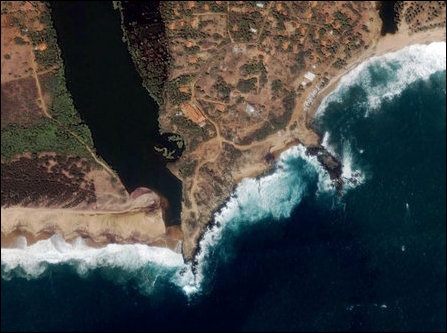
Godawaya located at the old mouth of the river Walawe Ganga. Note the rocky hillock marked by a circular road. The maximum height of the hillock is 58 meters above Mean Sea Level. [Image courtesy: Google Earth]
21.07.07
Ællegoda
External Links:















